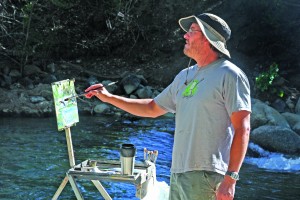In August I received a call from State Senator Gail Schwartz’s campaign manager asking if I’d like to meet with the senator as she was to be in Salida for a few days. As the only candidate running for office this year who’s contacted our office, I agreed.
We sat down on the sunny patio at Salida Café the same day that one of her legislative goals became a reality.
In 2004 Colorado voters approved Amendment 37 requiring the state’s investor-owned utilities to produce 15% of their power from renewable energy sources. House Bill 10-1001, of which Schwartz was a co-sponsor, passed the Senate on March 5, raising the Colorado renewable energy standard to 30% by the year 2020. It went into effect on August 9.
The bill now gives Colorado the highest renewable energy standard in the Rocky Mountain west. The hope is to create new jobs, stabilize rates for the long run and attract new businesses to the state. She feel that if we take advantage of our plentiful sunshine and wind and create a diverse portfolio of energy resources it might help Colorado become a leader in renewable energy.
The day before our meeting, Public Service Company of Colorado announced it will build a 30-megawatt solar plant in the San Luis Valley which will employ a new, concentrated solar panel which uses Fresnel lenses to maximize the amount of electricity generated by the sun. Once built it will be the largest concentrated photovoltaic solar farm in the world. It is projected to be in operation by 2012 and will power up to 6,500 homes. That brought up the issue of transmission which will probably require new power lines to be built against the wishes of some in the path of one of the proposed routes over La Veta Pass. An existing line currently runs over Poncha Pass and down the Arkansas River canyon. In order to meet the requirements set forth by Amendment 37, Xcel Energy and Tri-State Generation and Transmission Association, who will be purchasing the power from the new plant, need a way to get the state-mandated goal of 355 megawatts of solar power out of the San Luis Valley. They fear the route over Poncha Pass is vulnerable to overloads, forest fires and rockslides. The senator is aware of these issues and hopes a solution can be found to mitigate impact on scenery and wildlife but also provides a reliable way to transmit the “new energy” which the current and proposed solar facilities will help generate.
This led to the topic of community solar gardens. On June 5 the Colorado House passed HB10-1342, the Community Solar Gardens Act, sponsored by Rep. Claire Levy. The bill will allow groups of individuals to collectively own a solar array and be able to take advantage of the state’s net-metering laws. At least 10 subscribers can collectively own a share of a solar installation in their community and get credit or refunds on their electric bill. The electricity generated by these solar gardens does not actually go directly to the subscribers but is tied into the grid and net-metered to determine cost offsets. I personally would be thrilled to witness banks of solar arrays scattered throughout Salida knowing they are assisting in keeping the electrical generation system going locally and helping to reduce our dependence on our diminishing sources of oil and gas.
Despite promises by opposition candidates to repeal the state mandates, the new energy standard is having the desired effect as utility companies are proving they can tap alternative energy sources and maintain their business models and manufacturers are beginning to locate their operations here. Colorado may just be showing the way for the rest of the country as we continue to deal with increasing energy costs and the specter of peak oil.
– Mike Rosso


